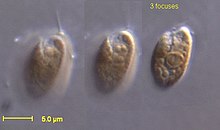The cryptophyceae are a class of algae,[1] most of which have plastids. About 220 species are known,[2] and they are common in freshwater, and also occur in marine and brackish habitats. Each cell is around 10–50 μm in size and flattened in shape, with an anterior groove or pocket. At the edge of the pocket there are typically two slightly unequal flagella.
Some exhibit mixotrophy.[3]
| Cryptophytes | |
|---|---|
 | |
| Rhodomonas salina | |
| Scientific classification (incertae sedis within Eukaryota) | |
| Domain: | |
| (unranked): | |
| (unranked): | |
| Superclass: | |
| Class: | Cryptophyceae |
| Orders | |
| Synonyms | |
| |
https://en.wikipedia.org/wiki/Cryptophyceae
The plastid (Greek: πλαστός; plastós: formed, molded – plural plastids) is a membrane-bound organelle[1] found in the cellsof plants, algae, and some other eukaryotic organisms. They are considered to be intracellular endosymbiotic Cyanobacteria. Examples include chloroplasts (used for photosynthesis), chromoplasts (used for pigment synthesis and storage), and leucoplasts (non-pigmented plastids that can sometimes differentiate).
https://en.wikipedia.org/wiki/Plastid
A plasmid is a small, extrachromosomal DNA molecule within a cell that is physically separated from chromosomal DNA and can replicate independently.
https://en.wikipedia.org/wiki/Plasmid
A plasmoid is a coherent structure of plasma and magnetic fields.
https://en.wikipedia.org/wiki/Plasmoid
 | |
| Mature P. vivax trophozoite |
 | |
| False-colored electron micrograph of a sporozoite |
No comments:
Post a Comment